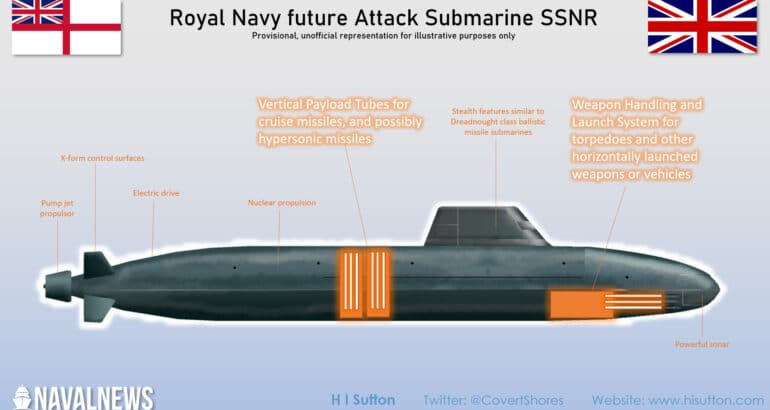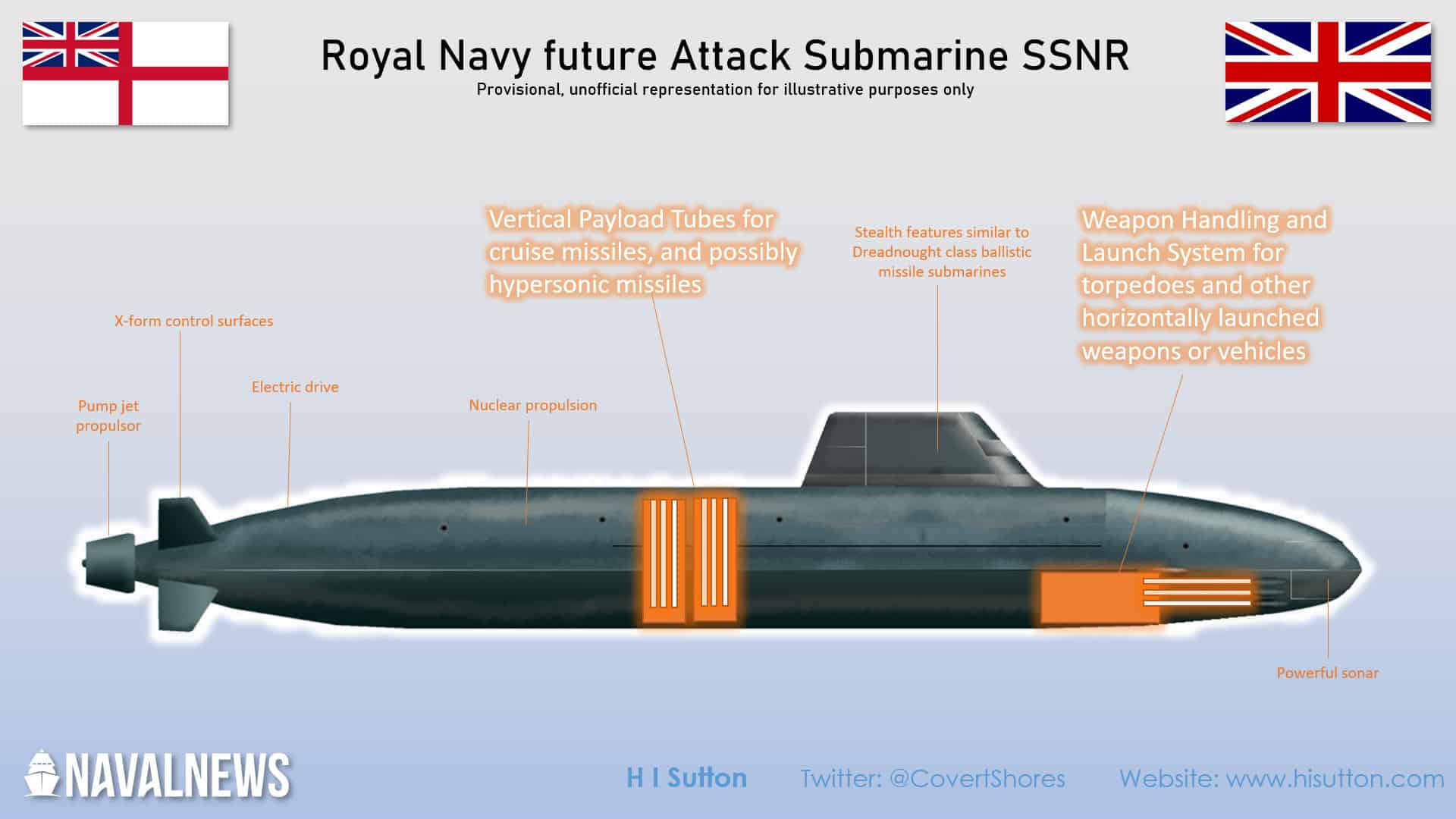Zarvan
ELITE MEMBER

- Joined
- Apr 28, 2011
- Messages
- 54,463
- Reaction score
- 87
- Country
- Location

The Royal Navy's SSNR submarine is understood to have both vertical launch tubes and a traditional torpedo room. This will give unprecedented flexibility and allow new U.S. designed weapons.
Britain’s New Attack Submarine To Be First With VLS
The future British attack submarine, the SSNR, will feature a vertical launch system (VLS). This is a first for the Royal Navy and will increase interoperability with American allies. This can be seen as a smart move, as the Ukraine War reinforces the importance of supply chains.
H I Sutton 19 Jan 2023The Royal Navy’s Astute Class attack submarines are among Britain’s most capable by any measure. They are the only subs outside the U.S. Navy able to launch the Tomahawk land attack cruise missiles, a capability which sets them apart.
SSNR
The last two of 7, HMS Agamemnon and HMS Agincourt, are still under construction in Barrow, England. But work is already well underway designing their replacement, the SSNR (Submersible Ship Nuclear, Replacement).Naval News understands that the SSNR will, unlike any previous Royal Navy attack submarine, have a vertical launch system (VLS). This will allow it to carry new missile types.
The merits of VLS, also called vertical payload tubes, has been a point of discussion with British defense community for years. The choice not to fit them to the Astute Class set them apart from the contemporary, and generally equivalent, U.S. Navy Virginia Class.
Until now the traditional torpedo room, known formally as the Weapon Handling and Launch System (WHLS) or informally as the ‘bomb shop’ in Royal Navy parlance, has been considered more flexible. It allows the weapons to be maintained from the crew while the submarine is underway. And it can be reloaded at sea, something which has proven difficult with VLS. And crucially, you don’t launch torpedoes vertically. This also means that the mix of missiles and torpedoes is more flexible and can be changed quite quickly to fit the mission. So, the torpedo room is here to stay.
Why Not Having a VLS is a Disadvantage
Yet there is a drawback for the Astute Class not having a VLS which may not be apparent in the technical explanations. The U.S. supplied Tomahawk cruise missiles for its torpedo tubes are becoming a legacy design. With the advent of the later Los Angeles class attack submarines in the 1980s the U.S. Navy introduced VLS to their fleet. The VLS requires a different sub-version of the missile.The last U.S. Navy attack submarines without VLS were the three Seawolf Class boats. These would still need the horizontally launched Tomahawk if they were to carry them. But the latest Virginia Class makes VLS standard across almost all the U.S. Navy submarine force now and in the future.
So, if the Royal Navy continues on a divergent track, sticking only to the torpedo room, it could become the only customer for horizontally launched Tomahawks. This is an expensive preposition. And Russia’s invasion of Ukraine has reinforced our understanding of the importance of supply chains. If Britain is the only operator of horizontally launched Tomahawks it could be a problem.
Taking this line of thought further, there is a real chance that future U.S. Navy cruise missiles will not have a horizontally launched option. This could mean the Royal Navy giving up its current status and ‘first night’ strategic conventional strike capability. So, for the Royal Navy the relative merits of a torpedo room versus VLS are less about naval architecture, and more about smart procurement.
Strategic Partnering
Having a VLS will mean increased interoperability with U.S. Navy. Retaining the common supply chain will also mean that the two navy’s can draw on each other’s stocks in times of need. If the Royal Australian Navy’s future AUKUS submarines have a VLS this is taken further.Looking ahead, including a VLS on the SSNR will also open the door to hypersonic weapons. These use their speed and agility to perform time-critical strikes while evading defenses. The Royal Navy is looking to become a “global leader in hypersonic weapons”. Possibly the SSNR, with it’s VLS, will play a major part in this transformation.
TAGS Royal Navy SSNR Submarine
Facebook Twitter Stumble linkedin PinterestMore
AUTHORS
Posted by : H I Sutton
H I Sutton writes about the secretive and under-reported submarines, seeking out unusual and interesting vessels and technologies involved in fighting beneath the waves. Submarines, capabilities, naval special forces underwater vehicles and the changing world of underwater warfare and seabed warfare. To do this he combines the latest Open Source Intelligence (OSINT) with the traditional art and science of defense analysis. He occasionally writes non-fiction books on these topics and draws analysis-based illustrations to bring the subject to life. In addition, H I Sutton is a naval history buff and data geek. His personal website about these topics is Covert Shores (www.hisutton.com)

Britain's New Attack Submarine To Be First With VLS - Naval News
The future British attack submarine, the SSNR, will feature a vertical launch system (VLS). This is a first for the Royal Navy and will increase interoperability with American allies. This can be seen as a smart move, as the Ukraine War reinforces the importance of supply chains.

